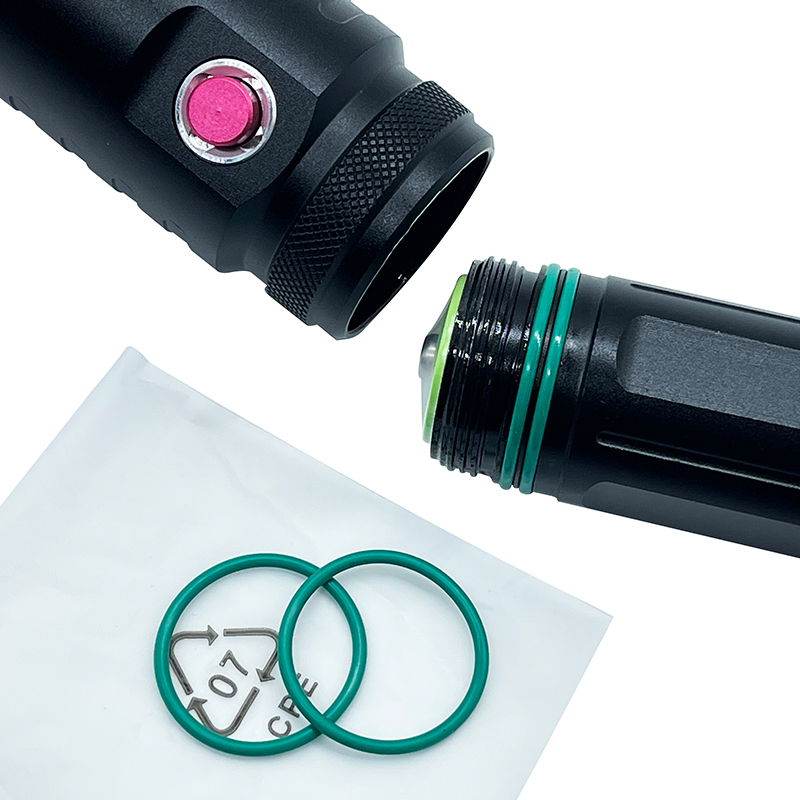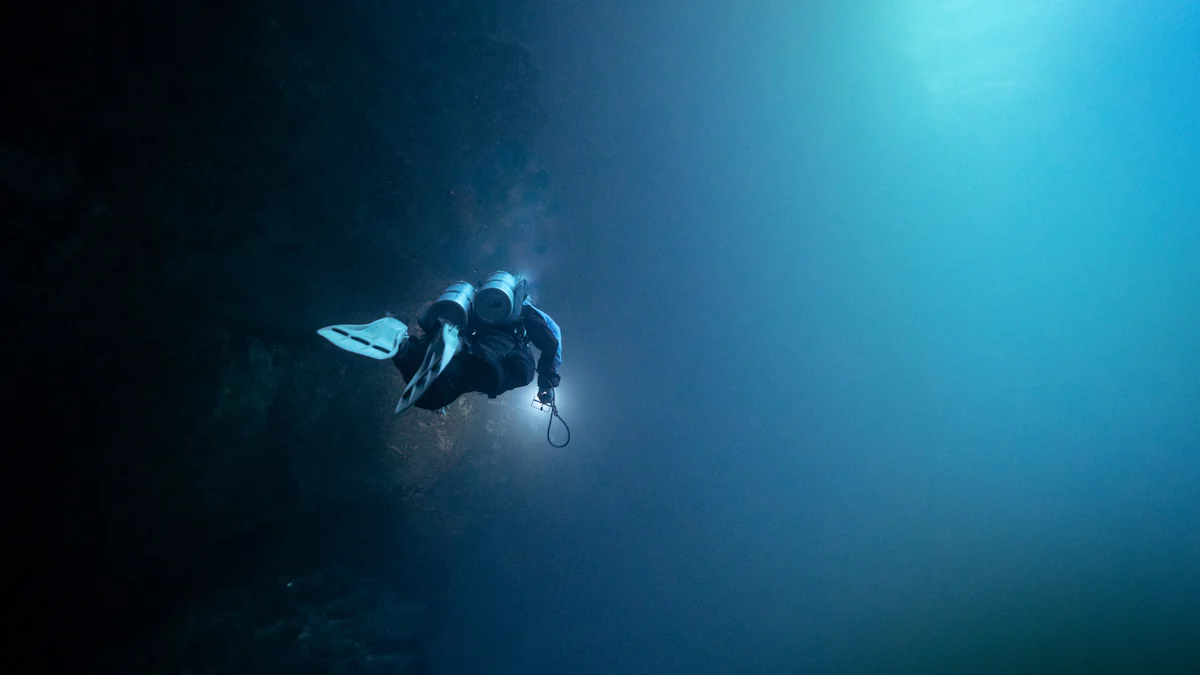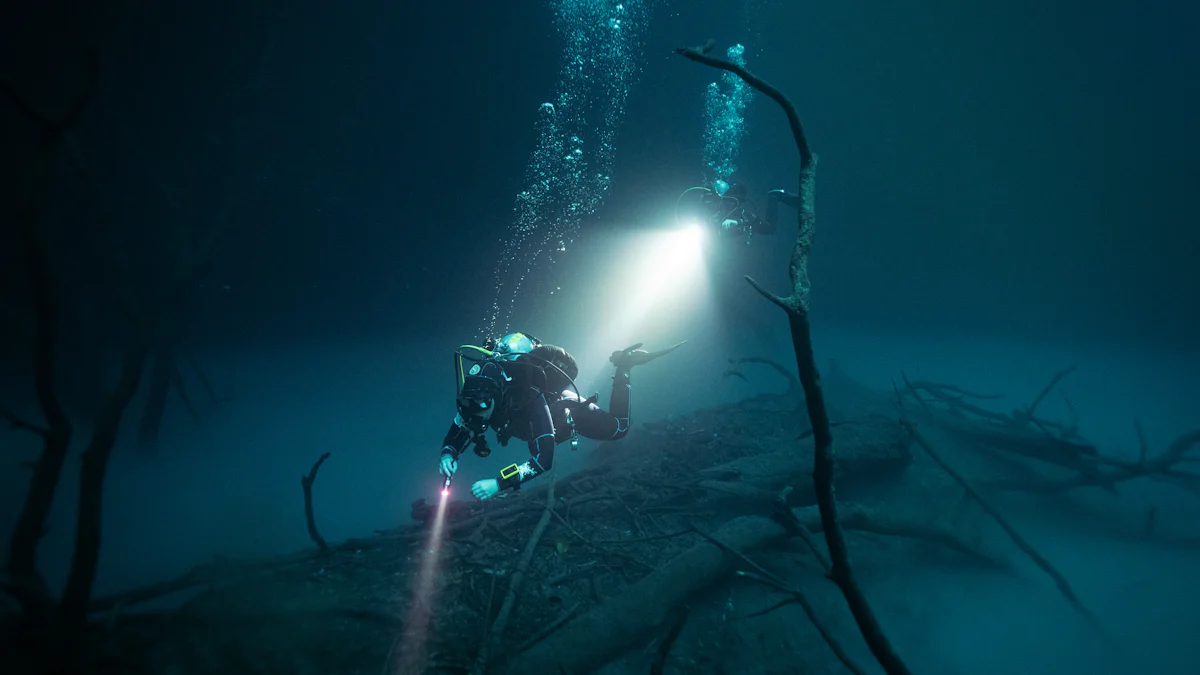Waterproof flashlights for underwater use

Exploring underwater environments requires proper tools to ensure safety and visibility. Waterproof flashlights are specially designed to function in wet conditions, making them essential for underwater activities. These flashlights allow you to see clearly in dark or murky waters, helping you navigate and avoid potential hazards.
Using a waterproof flashlight enhances your underwater experience by providing reliable illumination. Choosing the right one ensures durability and performance, whether you’re snorkeling, diving, or capturing underwater photos. A well-suited flashlight can make all the difference in your aquatic adventures.
Key Takeaways
Waterproof flashlights are important for underwater activities. They help you see clearly in dark or cloudy water, keeping you safe.
Knowing IPX ratings is very important. IPX7 flashlights are good for shallow water. IPX8 flashlights are better for deep diving and long underwater use.
Pick a flashlight that fits your needs. For fun activities, an IPX7 flashlight is fine. For serious diving or underwater pictures, choose an IPX8 flashlight.
Take care of your flashlight. Check seals and O-rings, clean it after using, and store it safely to keep it working well.
LED flashlights are the best for underwater use. They last longer, shine brighter, and are tougher than regular flashlights.
What makes a flashlight waterproof?

Understanding waterproofing
Difference between water-resistant and waterproof
Not all flashlights are created equal when it comes to handling water. A water-resistant flashlight can handle light rain or splashes but cannot survive submersion. It’s designed to resist water penetration to a limited extent, making it suitable for outdoor activities like hiking in wet weather. On the other hand, a waterproof flashlight is built to be completely watertight. You can fully submerge it without causing damage, making it ideal for underwater environments or extreme conditions. The difference lies in their construction and the level of protection they offer. Waterproof flashlights often feature sealed casings, rubber gaskets, and O-rings to prevent water entry, while water-resistant models lack these robust features.
Why waterproofing is essential for underwater use
When you’re underwater, the stakes are higher. Water pressure increases with depth, and even a small leak can render a flashlight useless. Waterproofing ensures that your flashlight remains functional, even in challenging conditions. Whether you’re diving, snorkeling, or conducting underwater inspections, a waterproof flashlight provides reliable illumination. It also protects the internal components from corrosion, ensuring durability over time. Materials like anodized aluminum or stainless steel are commonly used to enhance resistance to water and rust, making these flashlights a dependable choice for aquatic adventures.
The significance of IPX ratings
What are IPX ratings?
IPX ratings are a standardized way to measure a flashlight’s resistance to water. These ratings help you understand how well a flashlight can handle exposure to moisture or submersion. The higher the IPX rating, the better the protection. For example, an IPX1 rating means the flashlight can withstand dripping water, while an IPX8 rating indicates it can handle continuous submersion at specified depths.
Breakdown of IPX classes (e.g., IPX7, IPX8)
IPX7 and IPX8 are the most common ratings for waterproof flashlights. An IPX7-rated flashlight can be submerged in water up to 1 meter deep for 30 minutes. This makes it suitable for activities like kayaking or fishing. In contrast, an IPX8-rated flashlight offers superior protection. It can handle continuous submersion beyond 1 meter, making it perfect for deep-sea diving or underwater photography. These ratings ensure you choose the right flashlight based on your specific needs.
How to interpret IPX ratings for underwater use
Understanding IPX ratings helps you select the best flashlight for your underwater adventures. If you plan to snorkel or swim in shallow waters, an IPX7-rated flashlight will suffice. For professional diving or extended underwater use, opt for an IPX8-rated model. These ratings also indicate the flashlight’s ability to withstand water pressure at different depths, ensuring you have the right tool for the job.
Choosing the right waterproof flashlight
Identifying your needs
Recreational activities (e.g., snorkeling, swimming)
For recreational activities like snorkeling or swimming, you need a waterproof flashlight that balances functionality and ease of use. Look for models with sealed casings and components, such as rubber gaskets and O-rings, to prevent water ingress. Flashlights with an IPX7 rating work well for shallow water activities, while IPX8-rated models provide better protection for prolonged submersion. Materials like anodized aluminum or stainless steel resist corrosion, ensuring durability in wet environments. If you plan to explore saltwater areas, choose a flashlight designed to withstand saltwater corrosion for long-lasting performance.
Professional use (e.g., diving, underwater photography)
Professional activities like diving or underwater photography demand higher performance. You need a waterproof flashlight with an IPX8 rating or higher to handle continuous submersion at greater depths. These flashlights often feature advanced sealing mechanisms and corrosion-resistant materials to endure harsh underwater conditions. For underwater photography, opt for models with adjustable brightness and wide beam angles to illuminate your subject effectively. Saltwater resistance is also essential for marine environments to prevent damage from prolonged exposure.
Key features to look for
Waterproofing level (IPX rating)
The IPX rating determines how well a flashlight can handle water exposure. For underwater use, an IPX8 rating ensures reliability during deep dives or extended submersion. Always match the IPX class to your specific activity to avoid equipment failure.
Luminosity and beam distance
A bright flashlight with a long beam distance improves visibility underwater. LED waterproof flashlights excel in this area, offering high luminosity and focused beams that cut through murky water effectively.
Burn time and battery life
Long battery life is crucial for extended underwater activities. Choose a flashlight with efficient energy consumption to avoid interruptions during your adventures. Rechargeable batteries can be a practical option for frequent use.
Durability and ruggedness
Durability ensures your flashlight withstands the challenges of underwater environments. Look for models made from corrosion-resistant materials like anodized aluminum. Shockproof designs also enhance ruggedness, making the flashlight reliable in demanding conditions.
LED waterproof flashlights vs. conventional flashlights
Advantages of LED technology
LED waterproof flashlights offer several advantages over conventional models. They consume less energy while providing comparable or superior brightness, resulting in longer operational times. LEDs also have a longer lifespan, reducing the need for frequent replacements that could compromise waterproofing. Their compact size allows for designs that withstand high water pressure, making them ideal for diving.
Energy efficiency and brightness
LEDs deliver excellent luminous efficacy, ensuring extended run times and consistent brightness. This efficiency is particularly beneficial in underwater settings, where reliable illumination is critical. Their durability and resistance to impact make them a dependable choice for challenging environments.
Practical tips for using waterproof flashlights

Preparing your flashlight
Checking seals and O-rings
Before using your waterproof flashlight, inspect the seals and O-rings to ensure they are in good condition. These components are critical for maintaining a watertight seal. Follow these best practices:
Inspect the O-ring for cracks, cuts, or deformation. Replace it if you notice any damage.
Remove debris like sand or hair that could compromise the seal.
Apply silicone grease to the O-ring regularly to maintain its elasticity and sealing properties. Lubricate it after each use or at least once a month.
Properly maintained seals and O-rings prevent water from entering the flashlight, ensuring reliable performance during your underwater adventures.
Ensuring battery life is sufficient
A reliable battery is essential for uninterrupted use of your waterproof flashlight. To ensure sufficient battery life:
Use rechargeable flashlights for extended runtime.
Opt for models with adjustable brightness settings to conserve energy.
Carry high-quality spare batteries for emergencies.
Additionally, store batteries in a cool, dry place and follow the manufacturer’s guidelines for care. A flashlight with a longer runtime ensures you won’t be left in the dark during diving or other underwater activities.
Maintenance and care
Cleaning after use
After each dive, clean your waterproof flashlight to maintain its performance. Start by rinsing it thoroughly with fresh water, focusing on the buttons, O-ring, and seams. This removes salt and debris that could cause corrosion. Once rinsed, air dry the flashlight in a cool, ventilated area. Avoid direct sunlight, as it can degrade the materials over time.
Proper storage to ensure longevity
Proper storage extends the life of your waterproof flashlight. Follow these tips:
Store the flashlight in a cool, dry place to protect it from extreme temperatures.
Use a protective case to shield it from physical damage and dust.
Ensure the flashlight is completely dry before storing it to prevent moisture from affecting the internal components.
These steps help maintain the flashlight’s waterproofing and functionality for years to come.
Safety tips for underwater use
Avoiding overheating during prolonged use
Underwater environments can cause your flashlight to overheat if used for extended periods. To prevent this, avoid running the flashlight at maximum brightness for too long. Use adjustable brightness settings to reduce strain on the components. This not only prevents overheating but also conserves battery life.
Using the flashlight effectively in low-visibility conditions
Low-visibility conditions require strategic use of your waterproof flashlight. Follow these strategies:
Adjust the brightness based on water clarity to optimize visibility.
Familiarize yourself with the flashlight’s switch to operate it efficiently.
Be aware of the flashlight’s maximum depth rating to avoid damage.
These tips ensure you get the most out of your waterproof LED flashlights, especially during diving or other underwater activities.
Waterproof flashlights play a vital role in ensuring safety and visibility during underwater activities. Their precise design, featuring sealed casings, rubber gaskets, and corrosion-resistant materials like anodized aluminum, guarantees durability and reliability in wet environments. Rigorous testing ensures these flashlights perform well under real-world conditions.
When choosing a waterproof flashlight, consider these key factors:
IPX rating: Determines suitability for underwater use.
LED technology: Offers longevity and energy efficiency.
Luminosity and beam type: Provides bright, focused illumination.
Burn time: Ensures extended use without interruptions.
Durability: Withstands shocks and wear during rugged activities.
Prioritizing safety, quality, and durability ensures your flashlight performs reliably in any condition. Features like corrosion resistance, enhanced durability, and reliable performance in emergencies make these tools indispensable.
Feature | Benefit |
|---|---|
Reliability in All Weather | Ensures consistent brightness and functionality in harsh conditions. |
Enhanced Durability | Withstands drops and impacts, ideal for rugged outdoor use. |
Safety in Emergencies | Provides reliable performance in flooded areas or heavy rains. |
Investing in a high-quality waterproof flashlight enhances your underwater experience while keeping you safe. Choose wisely and enjoy your aquatic adventures with confidence!
FAQ
What is the difference between an underwater flashlight and a regular flashlight?
An underwater flashlight is designed to work in submerged conditions. It has sealed casings, O-rings, and waterproof materials to prevent water entry. Regular flashlights lack these features and fail when exposed to water.
How deep can a waterproof flashlight go?
The depth depends on the IPX rating. Flashlights with an IPX8 rating can handle continuous submersion beyond 1 meter. Always check the manufacturer’s specifications for exact depth limits.
Can I use a waterproof flashlight in saltwater?
Yes, but choose a flashlight made from corrosion-resistant materials like anodized aluminum. Rinse it with fresh water after use to remove salt deposits and prevent damage.
How do I maintain my underwater flashlight?
Rinse it with fresh water after each use. Check the O-rings for damage and apply silicone grease regularly. Store it in a cool, dry place to ensure longevity.
Are LED flashlights better for underwater use?
Yes, LED flashlights are more energy-efficient and durable. They provide brighter illumination and last longer than conventional flashlights, making them ideal for underwater activities.
See Also
Comparing Diving Flashlights With Standard Flashlights
Our Emergency Flashlight: Designed for Long-Lasting Use
Various UV Flashlight Types Utilized in Forensic Science
